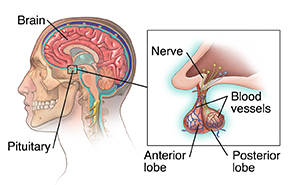Pituitary Tumor: Introduction
What is cancer?
Cancer starts when cells in the body change (mutate) and grow out of control. To help you understand what happens when you have cancer, let's look at how your body works normally. Your body is made up of tiny building blocks called cells. Normal cells grow when your body needs them, and die when your body doesn't need them any longer.
Cancer is made up of abnormal cells that grow even though your body doesn't need them. In most cancers, the abnormal cells grow to form a lump or mass called a tumor. If cancer cells are in the body long enough, they can grow into (invade) nearby areas. They can spread to other parts of the body, too (metastasize).
Understanding the pituitary gland
The pituitary gland is a small gland inside the skull, just below the brain. It's behind the nasal sinuses and above the roof of the mouth. The pituitary gland connects to a part of the brain called the hypothalamus. Together, the hypothalamus and the pituitary control the body’s production of many important hormones.
The pituitary gland sits in a tight, bony space. It has little room to grow or expand.
The pituitary gland controls most of the body’s gland activity. This includes the adrenal and thyroid glands. It also includes sex hormone production. In women, it controls egg production (ovarian function). In men, it controls testosterone and sperm production in the testicles.

The pituitary gland has 2 parts: the back part (posterior pituitary) and the front part (anterior pituitary). The posterior pituitary makes:
-
Vasopressin, also called ADH (antidiuretic hormone). This hormone helps the kidneys keep the right amount of water and not send it all out in urine. It can raise blood pressure by causing blood vessels to narrow or tighten.
-
Oxytocin. This female hormone helps the uterus contract during childbirth. It also helps the breasts release milk when a woman is nursing.
The anterior pituitary makes many kinds of hormones. They control other glands all over the body:
-
Growth hormone(GH or somatotropin). This hormone helps a child's body grow, especially during the teen years (puberty). It also helps the liver make something called insulin-like growth factor (IGF-1). IGF-1 causes bones and other tissues to grow. Adults don’t normally make a lot of GH.
-
Thyroid-stimulating hormone (TSH or thyrotropin). This hormone helps the thyroid gland to grow, and make and release the thyroid hormone. Thyroid hormone controls how your body turns food into energy (metabolism).
-
Adrenocorticotropic hormone (ACTH or corticotropin). This hormone stimulates the adrenal gland so that it can make certain steroid hormones like cortisol.
-
Luteinizing hormone (LH) and follicle-stimulating hormone (FSH), called gonadotropins. In women, these hormones control the menstrual cycle and ovulation, and the production of estrogen and progesterone. In men, they control testosterone and sperm production.
-
Prolactin. This helps make milk in a woman’s breast. It’s not clear how it works in men.
What is pituitary cancer?
Pituitary cancers are very rare. They are so rare that cancer agencies don’t keep track of how many people get them each year. They're often found in older adults. But they can happen at any age. They can spread to other parts of the body. These tumors often make hormones, just like many noncancer pituitary tumors do. In most cases, the only way to tell that a tumor is cancer is when it spreads to another part of the body. They can spread to the brain, spinal cord, meninges (covers the brain and spinal cord), or the bone around the pituitary gland, and rarely to other organs.
What are pituitary tumors?
A pituitary tumor is an abnormal growth in the pituitary gland. Most of these tumors are not cancer (benign). They're called adenomas. They don’t often spread outside of the pituitary gland. But they still can greatly affect your health. They can push on nearby nerves, blood vessels, and parts of the brain. And they may send out excess hormones.
Pituitary adenomas are grouped in two ways: by their size and by the kind of hormone they make.
Size
Pituitary adenomas are grouped into two sizes:
Both kinds of tumors can either make too much of one or more hormones (functional) or not make enough hormones to cause symptoms (nonfunctional). Most pituitary tumors are functional. This means they make excess hormones that can cause symptoms.
Hormones
Pituitary adenomas are also grouped by whether they make excess hormones. Those that do are called functional tumors. They are then grouped by the type of hormone they make.
Some tumors make more than one type of hormone. The most common of these make both growth hormone and prolactin.
A nonfunctional pituitary adenoma doesn’t make excess hormones. But it may cause problems by preventing the pituitary gland from working normally. Sometimes these tumors don't cause symptoms until the tumor is a certain size. When it's big enough, it may cause headaches and vision problems. Large pituitary tumors can crush normal pituitary cells. This leads to symptoms caused by decreased hormone production.
Talk with your healthcare provider
If you have questions about pituitary tumors or pituitary hormones, talk with your healthcare provider. Your healthcare provider can help you understand more about these tumors.